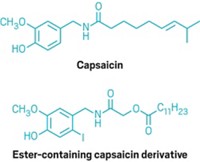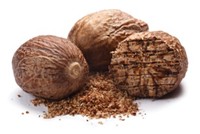Advertisement
Grab your lab coat. Let's get started
Welcome!
Welcome!
Create an account below to get 6 C&EN articles per month, receive newsletters and more - all free.
It seems this is your first time logging in online. Please enter the following information to continue.
As an ACS member you automatically get access to this site. All we need is few more details to create your reading experience.
Not you? Sign in with a different account.
Not you? Sign in with a different account.
ERROR 1
ERROR 1
ERROR 2
ERROR 2
ERROR 2
ERROR 2
ERROR 2
Password and Confirm password must match.
If you have an ACS member number, please enter it here so we can link this account to your membership. (optional)
ERROR 2
ACS values your privacy. By submitting your information, you are gaining access to C&EN and subscribing to our weekly newsletter. We use the information you provide to make your reading experience better, and we will never sell your data to third party members.
Natural Products
Nutmeg compound is even cooler than menthol
The spice molecule activates a cold-sensitive ion channel in neurons and could help extend menthol’s cooling effect
by Deirdre Lockwood
June 28, 2017

When you rinse with a menthol-flavored mouthwash, your mouth tingles because the compound triggers a cold-sensitive ion channel in sensory neurons in your mouth. Now scientists have found a new compound that is even more chilling. Isolated from nutmeg, this new chemical is the most potent activator of that cooling channel yet found in nature (ACS Med. Chem. Lett. 2017, DOI: 10.1021/acsmedchemlett.7b00104).
The cooling effect of this compound, part of a class of plant molecules called neolignans, comes on more slowly but lasts longer than menthol’s. The scientists at the Kao Corporation who isolated it think it could be mixed with menthol to extend the brisk feeling of mouthwashes, toothpastes, and other products. However, it still has several hurdles to clear before having a chance on the market, experts say.

L-Menthol, derived from mint, is the king of naturally derived cooling compounds, added to products from cough drops to cosmetics. It’s relatively cheap thanks to large-scale synthetic production. But it has some shortcomings: At low concentrations, its effect can be weak and short-lived, but bumping up its concentrations too high can cause irritation. So Kao and other consumer product makers have sought other cooling agents derived from natural sources, in part because natural flavors and fragrances have a greater market value than synthetic ones.
Tomohiro Shirai and his colleagues at Kao screened extracts of various botanicals and spices with an assay that measured activation of the ion channel, known as transient receptor potential melastatin 8 (TRPM8). An ethanol extract of dried nutmeg did the trick. The researchers eventually isolated and purified the compound responsible for the activation, though it wasn’t easy. “It took more than a year to find the natural extract and many years to identify the actual compound,” Shirai says.
The nutmeg compound is about 30 times as potent as L-menthol, and almost as potent as icilin, a synthetic cooling agent. The scientists also found that a particular stereoisomer of the compound is 116 times as potent as L-menthol, surpassing icilin. The nutmeg compound binds TRPM8 at a different site than menthol does, meaning that it would not compete with menthol’s effects if the two were combined.
The researchers then did a mouthwashing test by rinsing with a solution of the new compound for 30 seconds, and rating its cooling on a scale of 1 to 5 every five minutes for a half hour. “It showed very little irritation and only a cooling effect,” says Shirai. The nutmeg compound took five minutes to reach menthol’s initial level of cooling, but its cooling effect lasted longer—for 30 minutes compared with 10 minutes for menthol. This lag is probably because the compound’s molecular weight is about two and a half times that of menthol, and thus it has slower absorption in mucous membranes and on the skin, Shirai says.
The compound has a long way to go before it could be considered marketable, however, says John C. Leffingwell, a chemist and president of the flavor and fragrance consulting firm Leffingwell & Associates. Because of the small amounts found in nutmeg, this compound would need to be synthesized cheaply enough to be mass produced for the consumer market, a process Shirai and colleagues are working on. It would also need to pass tests for toxicity and taste. If the compound clears these hurdles, it might eventually find its way into products like mouthwash and toothpaste, Leffingwell says.






Join the conversation
Contact the reporter
Submit a Letter to the Editor for publication
Engage with us on Twitter